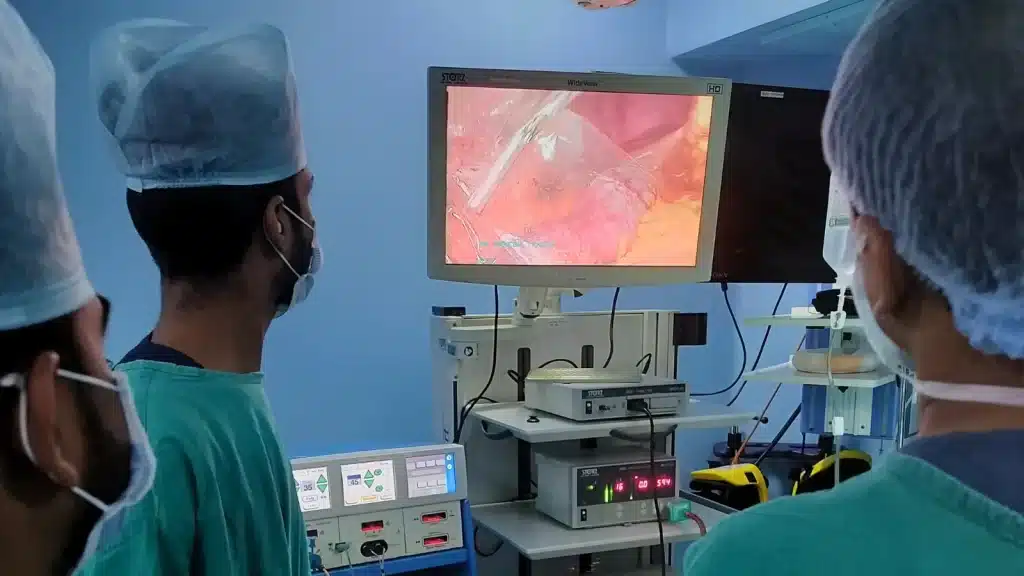Laparoscopic Ovarian Cystectomy
Ovarian cysts are fluid-filled sacs that develop on or inside the ovaries. While many ovarian cysts are harmless and may resolve on their own, some require medical intervention, particularly when they cause pain, disrupt normal bodily functions, or raise concerns about malignancy. At Sahaj Hospital in Indore, we specialize in laparoscopic ovarian cyst removal, offering a minimally invasive approach to treat this condition effectively while preserving reproductive health.
Why Choose Laparoscopic Ovarian Cystectomy?
Laparoscopic ovarian cystectomy is a preferred technique for removing cysts due to its minimally invasive nature, faster recovery time, and reduced risk of complications compared to traditional open surgery. Using small incisions and advanced surgical instruments, this procedure allows for precise removal of cysts, ensuring minimal impact on surrounding tissues and preserving ovarian function whenever possible.
This technique is especially beneficial for pediatric patients, adolescents, and women of reproductive age, as it safeguards fertility while effectively addressing the condition.
Our Specialties

Symptoms Indicating the Need for Ovarian Cyst Removal
While some ovarian cysts are asymptomatic, others may present noticeable symptoms that require medical attention. These symptoms include:
- Persistent or severe pelvic pain
- Painful intercourse
- Difficulties with bowel movements or increased urgency to urinate
- Heavy or irregular menstrual bleeding
- Abdominal bloating or swelling
If you experience any of these symptoms, a comprehensive evaluation is essential to determine the appropriate treatment.
Reasons for Laparoscopic Ovarian Cyst Removal
Laparoscopic cystectomy is typically recommended when:
- The cyst is large (diameter > 2.5 inches).
- The cyst appears solid or raises suspicion of malignancy.
- Symptoms such as pain or bloating interfere with daily life.
- The cyst’s characteristics suggest a potential risk of cancer, especially in younger patients.
Preoperative Preparations
Before undergoing laparoscopic ovarian cystectomy, your doctor will perform a thorough evaluation to ensure the procedure is safe and effective. Preoperative preparations may include:
- Physical examination and review of your medical history
- Blood and urine tests to assess overall health
- Imaging studies such as ultrasounds or CT scans to locate and evaluate the cyst
- Electrocardiogram (ECG) to check heart function if necessary
- Discussion about medications, including stopping blood-thinners at least a week before surgery
Patients are also advised to arrange for post-surgery transportation and assistance at home, and to fast for at least eight hours prior to the procedure.
How the Procedure Is Performed
Laparoscopic ovarian cystectomy involves the following steps:
- A small incision is made near the navel, and a laparoscope (a thin tube with a camera) is inserted.
- The surgeon inflates the abdomen with carbon dioxide gas to enhance visibility of internal organs.
- Additional small incisions are made to insert specialized instruments.
- The cyst is located, carefully excised, and removed.
- The removed tissue is sent for analysis. If cancer is detected, additional measures, such as removing one or both ovaries, may be necessary.
- Incisions are closed with sutures or staples.
In rare cases where laparoscopic surgery is not feasible, open surgery may be required.
Potential Risks and Complications
While laparoscopic ovarian cystectomy is generally safe, like any surgical procedure, it carries potential risks, including:
- Infection or bleeding
- Recurrence of the cyst
- Rare need for ovary removal
- Infertility in severe cases
- Blood clots or organ damage
Certain factors, such as smoking, obesity, or chronic diseases like diabetes, may increase the risk of complications. Patients with prior abdominal surgeries or those who are pregnant may face additional challenges. Discussing these risks with your doctor is crucial.
Postoperative Care and Recovery
Following laparoscopic surgery, most patients experience a quicker recovery compared to open surgery. You may experience mild pain, bruising, or swelling around the incision sites, which usually resolves within a few days. Your doctor will provide specific instructions on wound care, medications, and activities to avoid during recovery.
